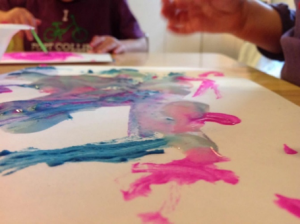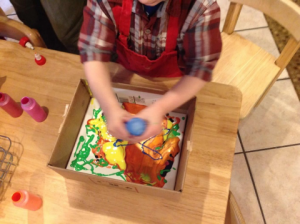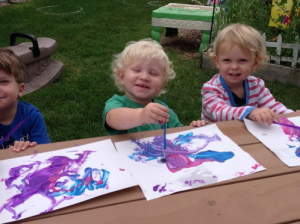Painting a Colorful World with Math
Children see the world with “big eyes.” It is a child’s profound curiosity and love of wonder that helps them understand others and their own place in the world. When I create spaces for learning, I want to envision the environment as children do. Combining math with artistic experiences is a great way to turn up the fun meter. This duo creates powerful right and left-brain learning as it presents the technical side of math in an artistic, colorful light. Creating an exciting math environment to embrace children at their interest level helps them to make important early connections. These connections support their potential for becoming strong math learners through-out their education.
Color blending is a fun, hands-on activity that encourages understanding about early math concepts. Creating an artistic, open-ended curriculum is an exciting way to explore math as descriptive language and problem-solving skills are formed.

We can help children build important connections through shape, line, and color and they begin to see form and portion as a distinct part of a larger picture. By discussing how to add more paint or less water, children learn to measure and estimate. They are beginning to identify with a world filled with many shades and hues. By focusing on art, we can easily shift the focus to math and the variety of ways it is used in our everyday experiences. Using numbers in collage, painting shapes, and drawing objects can help children use art as a basis for understanding math. The basic skills of vocabulary, description, sorting, matching, observing, and experimenting are inherent to color blending. Children will discover cause and effect, figure out solutions, and understand how things work in relation to their environment. These are all essential blocks in building an important foundation in math as well as necessary to each child’s educational journey.
The more we involve children’s senses in any artistic process, the more memorable the experience will be for them. Mixing paint with glitter or essential oils can become a celebration for the senses. With a little imagination, the simple act of painting becomes a colorful journey as primary colors transform into secondary colors right before a child’s eyes. Red and blue mix together and then, magically, purple arrives. Children will observe how every color began its journey as one of the three primary colors. This fact alone is fascinating as children will watch with wonder as this magical process evolves. Artistic experiences can evolve by adding a variety of art tools and textures. Children can paint with feathers, balls, or leaves and use the sidewalk or wood as a canvas. Sometimes the color of mud is made and then the marvel of mud pies could be investigated. Each new discovery can evolve into a higher level of learning. 
Since the love of all things new comes naturally to children, finding ways to incorporate their ideas will take their curiosity even further. Creating is effortless when children feel confident to express themselves. They will acquire new ideas through their creativity and learning becomes natural rather than a forced process through teacher-initiated activities. This inclusion helps to create a learning environment that is both meaningful and enjoyable. Children find comfort when their ideas are considered. By giving them a role in their learning experience, it will heighten their curiosity as well as their confidence.
As we investigate color and math with children, they begin to make connections to the importance it plays. Color is one of the first things children use to make distinctions between what they observe and how to describe it to others using their newly developing language. They find immense gratification in pointing out a red leaf by explaining its difference from the green one. Through this process, understanding how color can describe something is both enjoyable and useful for them. Color can excite, shift a mood, inspire, or remind us of a special memory. Children are delighted to discover the magic of color, it’s importance, and how it changes often by way of their imaginations.  By recognizing color, expressing observations, and understanding shape, line, and proportion; children are discovering how to use color to mathematically organize their world. Connections are discovered, and treasured memories are made.
By recognizing color, expressing observations, and understanding shape, line, and proportion; children are discovering how to use color to mathematically organize their world. Connections are discovered, and treasured memories are made.
I love the idea of using painting to help develop math skills and language. Each fall our class paints pumpkin shapes at an easel. I always use this opportunity to help introduce new math language to the children. We talk about how pumpkins are round, if what they are painting is big or small, tall or short, etc.
I like how it was tied into art and other activities in the classroom. Sometimes bringing it from other areas of the classroom day can be a great way to continue to allow them to learn.
Can you do the same with coloring sheets?
Awesome, using art with math is so much fun. My children love mixing colors together by measuring with teaspoons for example, one teaspoon of red with two teaspoon of yellow makes the colors orange.
Art is a fun way to make children learn plenty of things. I loved this idea
I believe art to be the core of expressing creativity in kids. Using it in math will not only inspire kids to more art, it will also help them to understand math more easily.
Using colors to explore math was meaningful and enjoyable. It applied problem solving skills, shapes, lines, portion, matching and much more.
Math and Art are a great combination to learn! It will help children to get creative but at the same time will make them think and recognize numbers, patterns, sizes, shapes and quantity.
Art has so many unique ways to teach math concepts as well as show each children unique creativity. There is also problem solving that can be taught by mixing colors to get new ones. Lets say a child wants to use purple paint but there is no purple paint then problem solving comes in as the child tries to figure out what colors need to be mixed together to get purple paint.